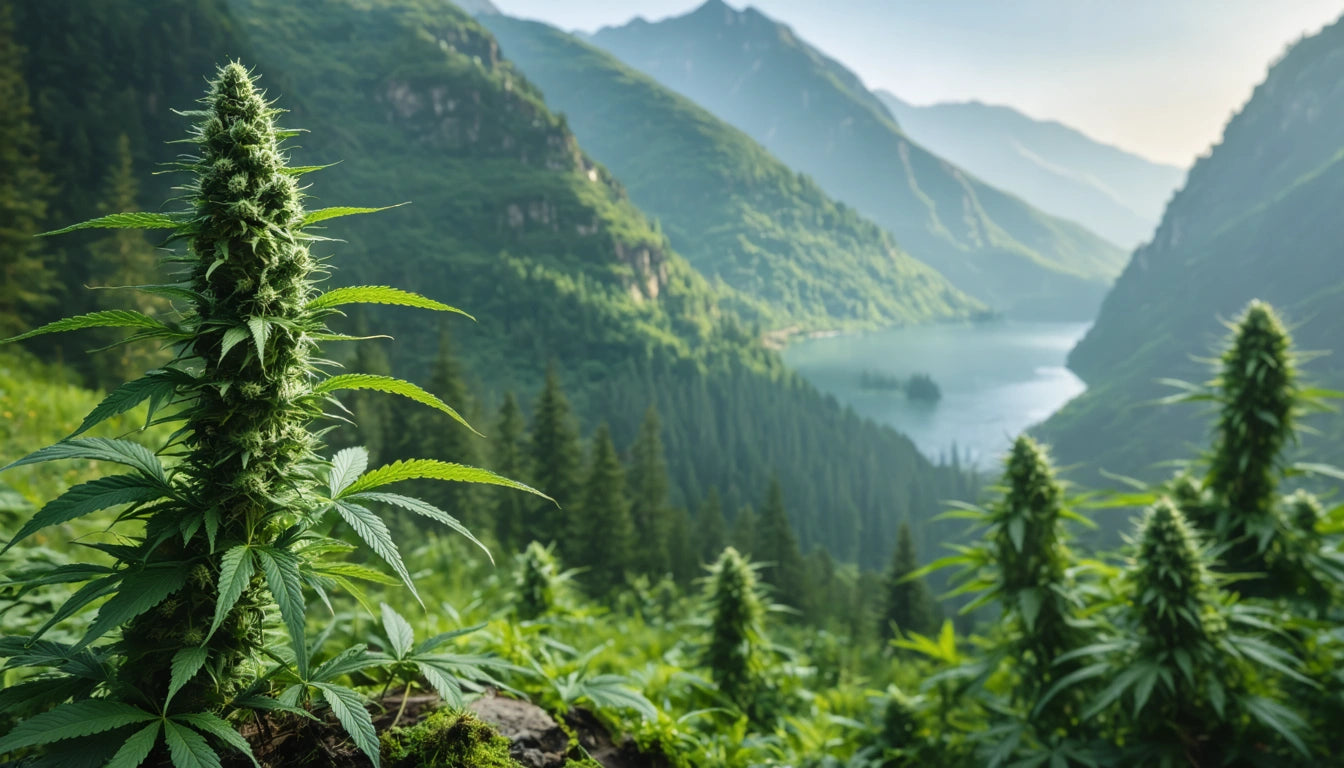Table of Contents
Exploring the Natural Habitats of Wild Cannabis: Where and How It Grows
Cannabis grows wild across several continents, adapting to diverse environments from mountainous regions to riverbanks. Understanding where wild cannabis thrives provides insight into the plant's remarkable adaptability and evolutionary journey. This exploration of natural cannabis habitats reveals how this versatile plant has spread globally while developing distinct regional characteristics.
Natural Habitats of Wild Cannabis
Wild cannabis typically flourishes in disturbed soils with good drainage and ample sunlight. The plant has evolved to thrive in regions with seasonal variations, particularly areas with distinct wet and dry periods. According to research on natural cannabis growth, these plants commonly appear along roadsides, abandoned fields, and riverbanks where competition from other vegetation is limited.
The plant's remarkable adaptability allows it to grow in various climates, though it generally prefers temperate to warm conditions with moderate rainfall. Wild cannabis populations have established themselves across Asia, Europe, Africa, and parts of North and South America, often in regions with a history of human cultivation.
Central Asian Origins: The Cradle of Cannabis
Cannabis originated in Central Asia, specifically in regions that now include parts of Mongolia, southern Siberia, and northern China. Archaeological evidence suggests cannabis has been utilized by humans for over 12,000 years, making it one of our oldest cultivated plants. The Hindu Kush mountain range, spanning Afghanistan and Pakistan, is particularly renowned for its indigenous cannabis varieties that have adapted to harsh mountain conditions.
These original wild populations developed high resin production as a defense mechanism against environmental stressors such as UV radiation and insect predation. This adaptation coincidentally produced plants rich in cannabinoids, which later attracted human interest for medicinal, spiritual, and recreational purposes as detailed in this history of marijuana origins.
Global Wild Cannabis Distribution
Asia
Beyond its Central Asian homeland, wild cannabis grows abundantly across the Indian subcontinent, particularly in northern India and Nepal. These regions feature landrace strains that have adapted to specific local conditions over thousands of years. In Kazakhstan and Russia, wild hemp grows in vast fields, sometimes covering hundreds of acres.
Europe and Africa
Cannabis spread to Europe through ancient trade routes, establishing wild populations in Eastern Europe, particularly in countries like Ukraine, Russia, and Romania. In Africa, wild cannabis grows primarily in countries along the eastern coast and highlands, including Ethiopia, Kenya, and South Africa, where it has been used traditionally for centuries.
Americas
In North America, wild cannabis or "ditch weed" appears primarily in the Midwest United States, descendants of hemp plants cultivated for fiber during World War II. These naturalized populations persist despite eradication efforts, demonstrating the plant's tenacity. The proper storage solutions with child-resistant features are essential when handling any cannabis product, even those derived from wild sources, to ensure safety and compliance with regulations.
Identifying Wild Cannabis Plants
Wild cannabis plants typically display several distinctive characteristics:
- Palmate leaves with serrated edges, typically featuring 5-7 leaflets
- Strong, fibrous stems that can grow 2-15 feet tall depending on conditions
- Distinctive aromatic compounds (terpenes) producing characteristic scents
- Separate male and female plants (dioecious), with females producing the distinctive flower clusters
- Annual growth cycle, completing its life cycle in a single season
While wild cannabis shares these basic characteristics with cultivated varieties, it often appears more scraggly and less uniform, having adapted for survival rather than human preferences.
Wild vs. Cultivated Cannabis: Key Differences
Wild cannabis differs significantly from its cultivated counterparts. Natural selection has optimized wild plants for reproduction and survival rather than THC production or other human-desired traits. Some key differences include:
Cannabinoid Content
Wild cannabis typically contains lower THC levels than selectively bred varieties. This addresses the question of whether you can smoke wild cannabis - while technically possible, wild plants generally produce less potent effects than cultivated strains. The THC:CBD ratio in wild plants tends to be more balanced, unlike modern recreational strains bred specifically for high THC content.
Growth Patterns
Wild cannabis grows more rapidly and produces seeds more quickly than many cultivated varieties. This accelerated life cycle helps ensure reproduction before seasonal changes or predation can threaten the plant. As explained in this exploration of marijuana origins, wild plants also exhibit greater genetic diversity within populations, providing resilience against pests and environmental challenges.
Survival Adaptations of Wild Cannabis
Wild cannabis has developed remarkable adaptations that enable its survival across diverse environments:
Seed Dispersal
The plants produce abundant seeds with hard outer shells that can remain viable in soil for years. This creates a persistent seed bank that allows populations to recover even after adverse conditions or eradication attempts.
Climate Resilience
Regional adaptations have produced varieties capable of withstanding extreme conditions, from the cold mountains of Afghanistan to the humid forests of Jamaica. These adaptations include varying flowering times, drought resistance, and cold tolerance.
Pest Resistance
Wild cannabis produces a complex array of terpenes and cannabinoids that deter many insect pests and herbivores. This chemical defense system has evolved over millennia and contributes to the plant's ability to thrive with minimal protection.
Conservation Considerations for Wild Cannabis
Wild cannabis populations face several threats, including habitat loss, eradication programs, and genetic contamination from cultivated varieties. Preserving these wild genetics is increasingly important as they contain valuable traits that could benefit future breeding programs, including disease resistance, climate adaptability, and unique cannabinoid profiles.
Conservation efforts focus on seed banking and protecting natural habitats where indigenous varieties grow. These initiatives help preserve the genetic diversity that has allowed cannabis to adapt to changing conditions for thousands of years and may provide solutions to agricultural challenges in an era of climate change.
Understanding where marijuana grows wild not only satisfies botanical curiosity but also helps inform conservation strategies and provides insights into the plant's remarkable evolutionary journey from wild Central Asian slopes to global cultivation.











Leave a comment
All comments are moderated before being published.
This site is protected by hCaptcha and the hCaptcha Privacy Policy and Terms of Service apply.